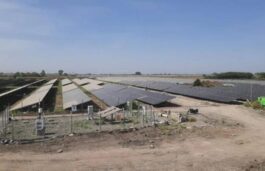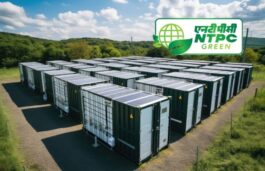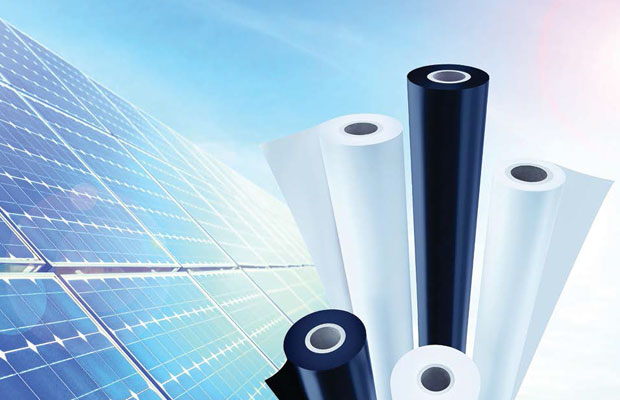

History of Bischof + Klein
In 1922, the company entered the packaging industry with the production of paper sacks for the neighbouring lime and cement works. Small paper packaging items and newspaper printing extended the product range. 1950 saw an increase in the production of consumer packaging. At the beginning of the 60s, B+K was amongst the pioneers in plastic processing and has been producing industrial packaging manufactured from plastic since 1963. From 1980 onwards, the consumer packaging range was extended with the expansion of plastic processing. This period also saw the establishment of a new division: Technical Films.
Focus in the Technical Films division is placed on the production of surface protection films, technical laminates, films for lamination and backsheets.
The B+K-GROUP manufactures its products using state-of-the art systems for mono/co-extrusion, gravure/HD-flexographic printing, solvent-based/solvent-free lamination and coating plus for extrusion lamination and coating. Highly-developed conversion technology with product-specific facilities for sealed, welded and adhesive designs enable individual production according to customers’ wishes.
Packaging for high-purity products is manufactured under clean room conditions in a separate production facility. Today, Bischof + Klein is one of Europe’s leading full-service suppliers of flexible plastic and plastic laminate packaging and technical films.
The new generation of backsheets
Backsheets are used for electrical safety and protection of PV modules against environmental influences. Due to its reflection of sunlight the backsheet also contributes to the efficiency of PV modules over all performance.
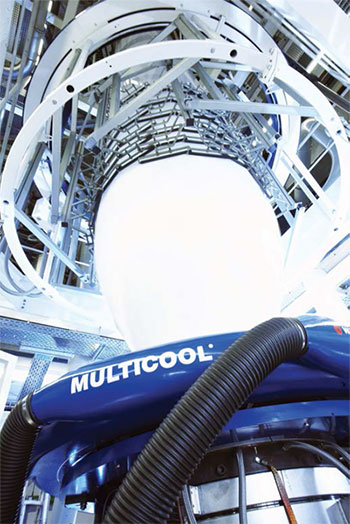
PV modules are installed worldwide and are, therefore, exposed to different climates with an aspired lifetime of more than 20 years. Degradation phenomena as hydrolysis, corrosion and yellowing can be caused by photochemical reaction due to ultra violet irradiation (UV) but also by the ingress of water vapour into the PV module.
B+K has developed a high technical backsheet for PV modules. By using an improved manufacturing process, Bischof + Klein created a market innovation called B+K BackFlex® PP. This backsheet is produced via co-extrusion in a single-step process (Fig. 1).
We want to compare the different backsheets TPT, TPE and PPE with our B+K BackFlex® PP in terms of reliability, electrical safety, shrinkage and influence on PV module performance. The TPT, TPE and PPE are standard ones and established on the market. They all are glue laminated types having a thick PET core layer in common but differ in the used outer layer (PVF or stabilised PET).
B+K BackFlex® PP stands for outstanding stabilisation against UV irradiation exhibiting no yellowing under desert climates but also under tropic zones which offer also elevated temperatures and high humidity. Water is part of our atmosphere and is absorbed by polymeric materials where it can cause hydrolysis effects (e.g. embrittlement). Especially polyester (PET) is prone to hydrolysis based on its polymeric structure. B+K BackFlex® PP is based on polypropylene and, therefore, is resistant to hydrolysis by nature. It can withstand more than 5.000 hours of damp-heat testing (85°C / 85% r.h.) (Fig. 2).

The ingress of water vapour into PV modules can cause corrosion of the metallic components but also hydrolysis of the encapsulant EVA which leads to acetic acid. B+K BackFlex® PP reduces the water ingress by more than 50% compared to market standards.
The characterisation of the water vapour transmission rate (WVTR) were carried out with a commercial Mocon test device at 38°C and 90% relative humidity (Fig. 3).
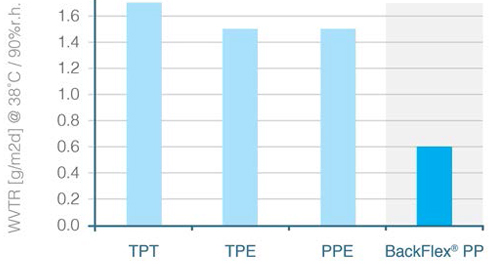
The results show values of 1,7 to 1,5 g/m²d for the backsheets containing a thick PET core layer (TPT, TPE and PPE). The coextruded PP offers a transmission rate of 0,6 g/m²d. The ingress of water vapour triggers also degradation phenomena over time as corrosion and hydrolysis. Therefore, the WVTR should be as low as possible.
To investigate the resistance against UV and moisture the backsheets were exposed to more than 200 cycles of a Q-UV-chamber. One cycle exists of eight hours of UV irradiation (fluorescent tube) followed by 4 hours of humidity condensation at 50°C. The total dose of UV irradiation was around 120 kWh/m² (Fig. 4).
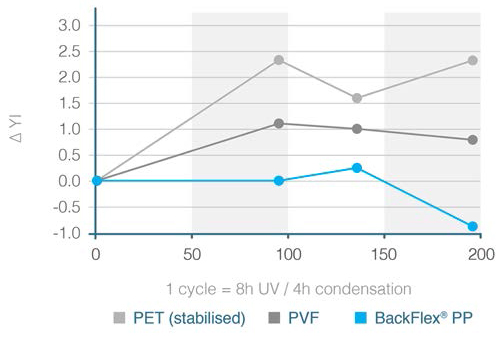
Here, the B+K BackFlex® PP shows excellent weather ability between the investigated grades.
Electrical safety plays also an important role in PV module certification (IEC 61730). Therefore, it has to be tested respectively the backsheet’s break through voltage and the partial discharge. These measurements were carried out at TÜV Rheinland and VDE. The PET-based materials offer a partial discharge ranging from 1,057 V (TPT) to 1,236 V (PPE) in contrast to 1,330 V of the PP backsheet. The break down voltage revealed bigger differences between the investigated material classes (Fig. 5).
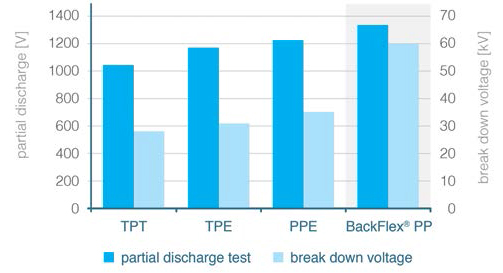
investigated backsheets
PV modules are usually produced in a vacuum lamination process at around 150°C for approximately 15 min., depending on the used embedding film. During this process the shrinkage of the used material, e.g. the encapsulant and backsheet, shall be as low as possible. Therefore, all materials were stored in an oven for 15 min. at 150°C and analysed regarding shrinkage. The results demonstrate a shrinkage of lower than 0,2% for the of B+K BackFlex® PP and more than 1% for the PET core based ones.
The energy yield of a PV module depends from several factors started by the solar cell. But also the backsheet contributes to it by reflecting solar light between the cells. By optical measurements of all components as glass, encapsulant and backsheet the module efficiency expressed as an Isc gain can be calculated. This approach was used to compare the different backsheet types (Fig. 6).
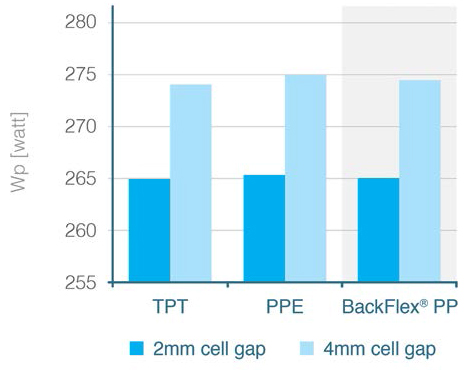
Summary
With the new B+K BackFlex® PP Bischof + Klein introduces a new generation of backsheets in the photovoltaic industry with the best performance for the PV module. Not only the reflectance of sunlight is better compared to common backsheets, but also the reliability, the electrical safety and the energy saving.
B+K BackFlex® PP is produced via co-extrusion in a single-step process. Therefore, neither glue nor solvents are required. This energy saving production and the longevity makes B+K BackFlex® PP all in all to a more sustainable product.
The PV module with B+K BackFlex® PP can be installed without any restriction in any region worldwide with harsh climate conditions in the desert, in floating islands or also in the sea. “We want to structure the future!” This intent runs throughout Bischof + Klein’s entire corporate history. The family-owned company thinks in terms of generations. This gives rise to the modern concept of “sustainability”. For B+K this balance between economy, social responsibility and ecology forms part of the company’s tradition.
In India our partner M/s Bergen Associates Pvt. Ltd is the exclusive partner offering support for stocking, selling and application support.


